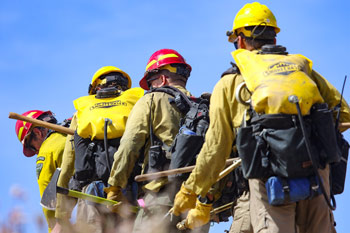Click Here for California Fires
July 30, 2024 - Currently, 89 large active wildfires are being managed nationwide, and have burned 2,123,318 acres. So far in 2024, 27,982 wildfires have burned 4,247,895 acres. People have caused  more than 25,000 wildfires that have burned nearly 3 million acres. Lightning ignited about 2,740 wildfires and burned 1.1 million acres.
more than 25,000 wildfires that have burned nearly 3 million acres. Lightning ignited about 2,740 wildfires and burned 1.1 million acres.
More than 27,000 wildland firefighters and support personnel are assigned to wildfires, including 29 complex and 6 Type 1 incident management teams, 605 crews, 1,597 engines, numerous aviation resources, and four Modular Airborne Fire Fighting Systems, or MAFFS.
Active to extreme fire behavior continues across multiple geographic areas, with evacuation orders in effect on 22 wildfires. If you live in an area that has been evacuated, please follow the instructions from local authorities. They will provide the latest recommendations based on the threat to your community and appropriate safety measures.
There are fuels and fire behavior advisories in place for Southwest Oregon, the region east of the Cascades in Oregon and Washington, Nevada, Southern Idaho, Utah, and California. Residents, travelers, or workers on their way to any of these states should be advised and familiarize themselves with the elevated risks.
The national predictive services staff at the National Interagency Coordination Center released the National Significant Wildland Fire Potential Outlook for July through October. For additional information about the current outlook visit the Outlook page on the NICC site.
As we see numerous fires across the country growing very large and threatening communities, it is important to remember that initial attack on new fires remains of the utmost importance. The vast majority of fire starts are contained at small sizes within 24 hours of their discovery; these are the fires that do not ever get large enough to be included in the incident management summary report. Thus, having firefighters and firefighting resources available for initial attack, especially in areas where predictive services say there is a high likelihood for new starts, is also a critical consideration during the busiest part of the fire year, when there is such a strong need for resources to fight the biggest blazes.
Much cooler and more humid weather will overspread the Northwest, northern Great Basin, and western parts of the northern Rockies behind a passing cold front. Showers and a few thunderstorms will produce areas of beneficial rain, especially in western Montana and northern Idaho. A few dry lightning strikes are possible, generally towards the southern edge of precipitation. Areas ahead of the front, from southeastern Montana through the Rockies, southern Great Basin, and Desert Southwest will continue to see very dry conditions, with widespread single-digit minimum relative humidity values likely once again. Dead fuel moisture will continue to trend well below normal, with the risk for lengthy burn periods expanding across the region. West- southwesterly winds gusting from 30-50 mph will be common across parts of the Great Basin into far southern Montana, Wyoming and parts of the West Slope. Gusts locally in these areas may exceed 60 mph with thunderstorm outflows and areas of downslope flow. Monsoonal activity will stay put over southeast Arizona, New Mexico, and far southern Colorado. Meanwhile, highs above 100 degrees over much of Kansas, Oklahoma, and northwestern Texas will combine with breezy southerly winds and relative humidity as low as 20-25% to promote a continued drying trend and possible increase in initial attack. There are no fire environment concerns in the eastern half of the country, where high humidity and areas of rainfall will continue.
| Number of new large fires or emergency response * New fires are identified with an asterisk |
4 | States currently reporting large fires: |
| Total number of active large fires Total does not include individual fires within complexes. |
89 | |
| Acres from active fires | 2,123,318 | |
| Fires contained | 4 |
Year-to-date statistics
| 2024 (1/1/24-7/30/24) | Fires: 27,982 | Acres: 4,247,895 |
| 2023 (1/1/23-7/30/23) | Fires: 30,219 | Acres: 1,139,857 |
| 2022 (1/1/22-7/30/22) | Fires: 39,063 | Acres: 5,702,152 |
| 2021 (1/1/21-7/30/21) | Fires: 37,392 | Acres: 2,978,085 |
| 2020 (1/1/20-7/30/20) | Fires: 31,632 | Acres: 2,052,246 |
| 2019 (1/1/19-7/30/19) | Fires: 26,465 | Acres: 3,179,054 |
| 2018 (1/1/18-7/30/18) | Fires: 37,591 | Acres: 4,772,098 |
| 2017 (1/1/17-7/30/17) | Fires: 38,617 | Acres: 5,409,500 |
| 2016 (1/1/16-7/30/16) | Fires: 33,617 | Acres: 3,428,322 |
| 2015 (1/1/15-7/30/15) | Fires: 35,779 | Acres: 5,608,144 |
| 2014 (1/1/14-7/30/14) | Fires: 33,185 | Acres: 1,623,318 |
10-year average Year-to-Date
| 2014-2023 | Fires: 34,043 | Acres: 3,578,875 |
Source: NIFC








